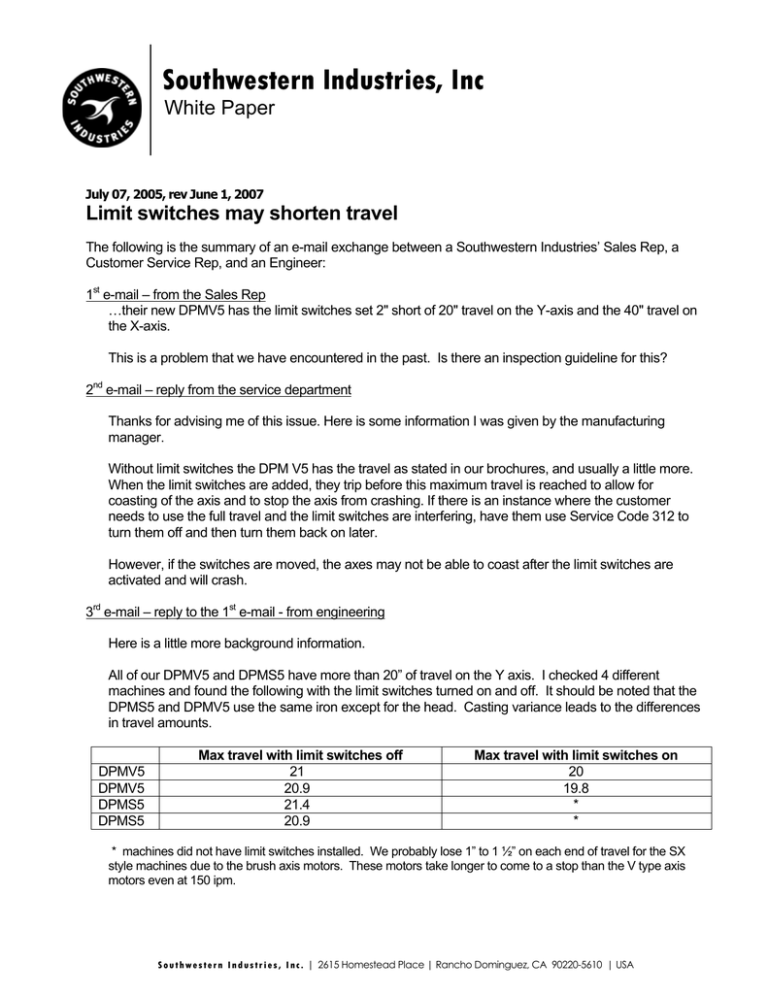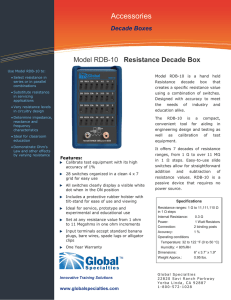
Southwestern Industries, Inc
White Paper
July 07, 2005, rev June 1, 2007
Limit switches may shorten travel
The following is the summary of an e-mail exchange between a Southwestern Industries’ Sales Rep, a
Customer Service Rep, and an Engineer:
1st e-mail – from the Sales Rep
…their new DPMV5 has the limit switches set 2" short of 20" travel on the Y-axis and the 40" travel on
the X-axis.
This is a problem that we have encountered in the past. Is there an inspection guideline for this?
2nd e-mail – reply from the service department
Thanks for advising me of this issue. Here is some information I was given by the manufacturing
manager.
Without limit switches the DPM V5 has the travel as stated in our brochures, and usually a little more.
When the limit switches are added, they trip before this maximum travel is reached to allow for
coasting of the axis and to stop the axis from crashing. If there is an instance where the customer
needs to use the full travel and the limit switches are interfering, have them use Service Code 312 to
turn them off and then turn them back on later.
However, if the switches are moved, the axes may not be able to coast after the limit switches are
activated and will crash.
3rd e-mail – reply to the 1st e-mail - from engineering
Here is a little more background information.
All of our DPMV5 and DPMS5 have more than 20” of travel on the Y axis. I checked 4 different
machines and found the following with the limit switches turned on and off. It should be noted that the
DPMS5 and DPMV5 use the same iron except for the head. Casting variance leads to the differences
in travel amounts.
DPMV5
DPMV5
DPMS5
DPMS5
Max travel with limit switches off
21
20.9
21.4
20.9
Max travel with limit switches on
20
19.8
*
*
* machines did not have limit switches installed. We probably lose 1” to 1 ½” on each end of travel for the SX
style machines due to the brush axis motors. These motors take longer to come to a stop than the V type axis
motors even at 150 ipm.
S o u t h w e s t e r n I n d u s t r i e s , I n c . | 2615 Homestead Place | Rancho Dominguez, CA 90220-5610 | USA
Limit Switches
Date: 07.07.05
Rev. 06.01.07
The V machines (both mills and lathes) need approximately ½” to stop from 250 ipm. If the limit switches
are set to maximize travel, you still lose 1” overall on each V machine. It should be noted that we do not
necessarily adjust the limit switches to attain the largest amount of travel during inspection, but we do
verify the 20” inches of travel with the limit switches off.
We knew this fact when we launched the product and decided it made more sense to state 20” for Y travel
versus 19”. From a sales standpoint, doesn’t it sound better? I think we made the right call because you
can still get at least 20” of travel by turning the limit switches off. If you must attain 20” of travel and the
limit switches are set so you cannot, then go to service code 312 under section B of our code section to
turn the switches off. This service code toggles the limit switches on and off (Note – it is currently only
possible on V machines to turn the limit switches off). We feel this is a minor inconvenience for the
customer who may have a job once or twice a year that requires 20”. Our new 2.0 SX software, along with
a hardware change to our cable breakout box when released, will also allow the limit switches to be turned
on and off. Users with the old style cable breakout box will not have this ability.
The customer should be able to adjust his limit switches without needing a service call. Our design allows
for adjustment by a user. All you need is a small metric allen wrench to adjust the cam. Each cam has
about 2” of travel for movement.
Note:
We believe that crashing a machine at the high speeds and power produced by the brushless
servo motors of the V Series may be more damaging to the machine than the brush motors of other
DPMs. This warrants standard limit switches as a precaution. However, in our tests, machines have not
been significantly damaged even after repeated crashes.
©2005 Southwestern Industries Incorporated. All rights reserved.
The information contained in this document represents the current view of Southwestern
Industries, Inc., on the issues discussed as of the date of publication. Because Southwestern
Industries must respond to changing market conditions, it should not be interpreted to be a
commitment on the part of Southwestern Industries, and Southwestern Industries cannot
guarantee the accuracy of any information presented after the date of publication.
This White Paper is for informational purposes only. SOUTHWESTERN INDUSTRIES MAKES NO
WARRANTIES, EXPRESS OR IMPLIED, IN THIS DOCUMENT. WP070705
z Page 2




